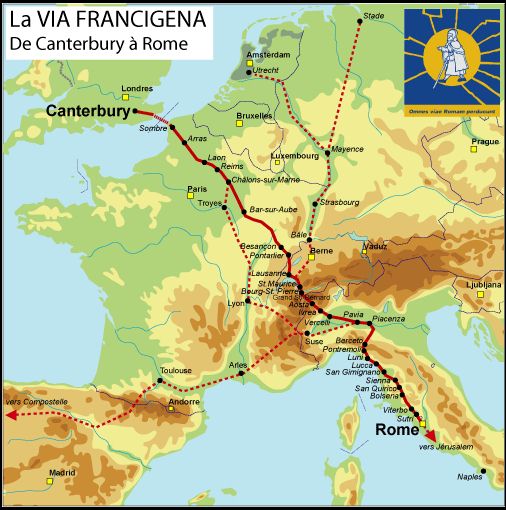Listening to me is more a saunter than a hike.
 I meant to tell you about Sigeric the Serious. With a nod to my Patheos sponsor, James Ford, whose “Monkey Mind” posts tend to wander more than march, let me tell you about this character whose moniker sounds more like a character from “The Princess Bride” than actual history.
I meant to tell you about Sigeric the Serious. With a nod to my Patheos sponsor, James Ford, whose “Monkey Mind” posts tend to wander more than march, let me tell you about this character whose moniker sounds more like a character from “The Princess Bride” than actual history.
Sigeric (the only name he had or that we know) was a Catholic Cleric in England during the 10th century. Nothing is known of his youth but he was educated and became a monk at Glastonbury Abbey then subsequently elevated to abbot of St. Augustine’s Abbey, which are quite distant from each other, the former being even closer to the Irish Sea than the latter is to the English Channel. St. Augustine’s is in Canterbury, and Sigeric was eventually made Archbishop of Canterbury, but only after being elevated to bishop of Ramsbury (by St. Dunstan, who makes a literary cameo in Dickens’ Christmas Carol) which is about halfway between the two.
This means little in itself, except that most people in 10th century Europe never went further than 20 miles from their birthplace and Sigeric traveled essentially across England twice before being named Archbishop of Canterbury by the pope.
Here is when he becomes someone worth knowing.
 Roman Catholic archbishops are entitled to a pallium, a liturgical garment, from the pope. But you had to go and get it from the pope. No UPS then. And if most people never left the county in which they were born, a tiny sliver went across borders and mountains and back. Doing so for a small garment was proof of one’s loyalty, which was precisely the point. Starting home in 990, the record of his trip is among the oldest extant pilgrim accounts in Western Europe. His stopping places, usually churches or abbeys of course, make a nearly straight line from Rome northwest to Canterbury.
Roman Catholic archbishops are entitled to a pallium, a liturgical garment, from the pope. But you had to go and get it from the pope. No UPS then. And if most people never left the county in which they were born, a tiny sliver went across borders and mountains and back. Doing so for a small garment was proof of one’s loyalty, which was precisely the point. Starting home in 990, the record of his trip is among the oldest extant pilgrim accounts in Western Europe. His stopping places, usually churches or abbeys of course, make a nearly straight line from Rome northwest to Canterbury.
That route still exists, though less organized than the Camino de Santiago, and is called the Via Francigena, Italian for The French Road. If you read my earlier post, it was this journey I was all set to begin in April of 2020. But – Covod. It runs about 1000 miles altogether, crossing France, over the St. Bernard Pass which is quite high (think dogs with casks of brandy around their necks) then down the Italian peninsula. The famous hospice (where the dogs were kenneled) sits at the high point, which is 8100 feet above sea level, and was built around 1050 so Sigeric and his companions made over the pass on their own.
Never heard of the Via Francigena?
That’s OK. I had not either until I saw the beginning point at Canterbury Cathedral on my last day walking Chaucer’s path from the Tabard Inn in Southwark London. To find out after walking 200 miles (I walked from both London and Winchester) that there was another path made it  irresistible. My hope to go remains, but my hope right now is that you sense how frail the pilgrim life can be – dependent on forces that are entirely outside your foreknowledge or control.
irresistible. My hope to go remains, but my hope right now is that you sense how frail the pilgrim life can be – dependent on forces that are entirely outside your foreknowledge or control.
Pilgrim life is an exercise in vulnerability.
 That has been deeply true of pilgrims from long ago like Sigeric. Not only was there less infrastructure there was much more danger: hostile governments, inadequate government, abundant highwaymen, unsafe food and water. The very idea of pilgrimage is foolish.
That has been deeply true of pilgrims from long ago like Sigeric. Not only was there less infrastructure there was much more danger: hostile governments, inadequate government, abundant highwaymen, unsafe food and water. The very idea of pilgrimage is foolish.
Yes it is better now, but even today, with maps and cell coverage, I have been lost. Even with modern clothing I have gotten blisters and chills. I have had a few moments of genuine fear, a few more of confusion, and many of uncertainty. The emotional satisfaction of pilgrim life is at least in part relief that you made it. That and knowing that in treading the paths generations before did, putting your feet where ancestors put theirs, creates a certain sense of being connected to them and their world. Blisters are blisters no matter the century, and being soaked by the rain feels pretty much the same in the 21st as the 10th century. Pilgrim life is one of “most common denominators” – breathing, walking, eating, resting. That’s what makes it holy.












